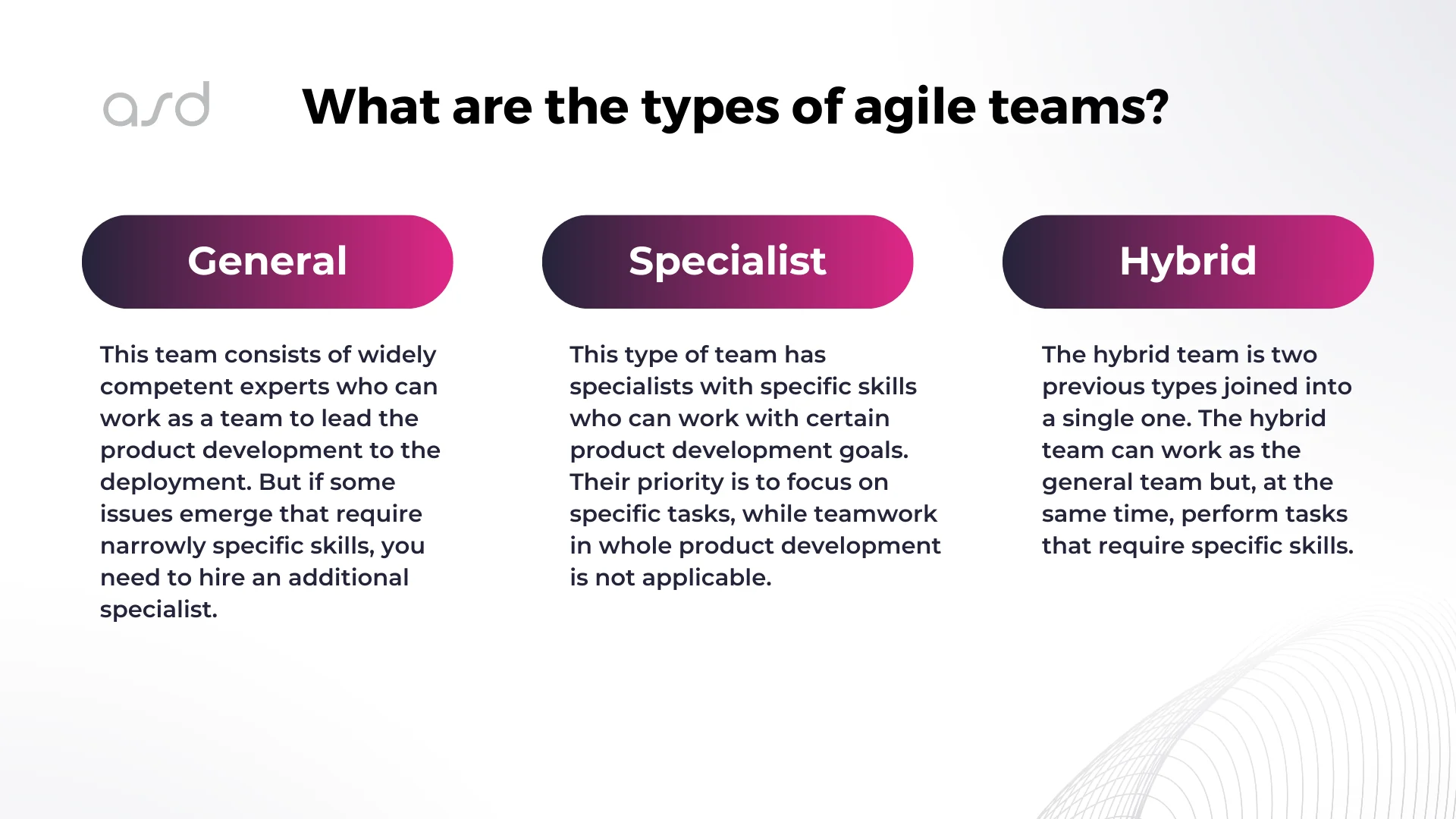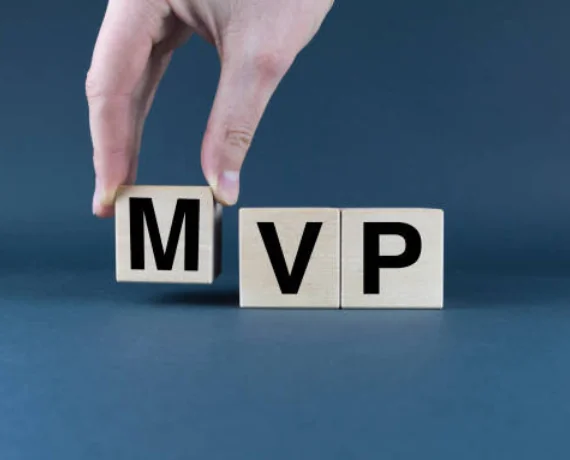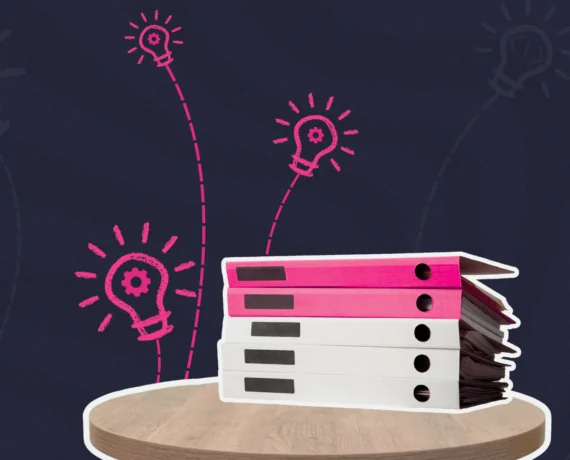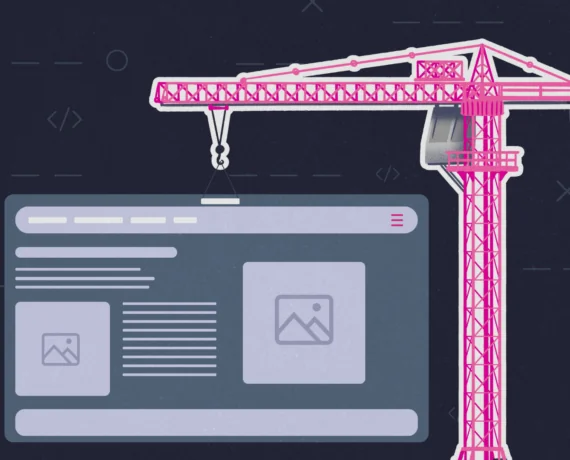Table of Content
- Agile methodology in software development
- Key elements of agile process
- Values of agile team
- Why do companies choose the agile?
- Traditional project management VS Agile
- Agile Frameworks and Methodologies
- Assembling the right Agile team
- Types of agile teams
- Structures of the development team
- Specialists of the Agile team
- Roles & responsibilities of the Agile team
- Typical Agile Team Structure
- Must-have tools for Agile Teams
- Agile Development Process
- Stages of the Agile Methodology
- Steps on how to build a high-performing agile team
- Tools and Technologies for Agile Teams
- Agile Development Best Practices
- Signs you have a productive Agile team
Let's form your ideal Agile team
Book a callWhat is agile methodology in software development?
Agile is now a fancy notion among team landscapes. An agile environment is crucial in facilitating iterative processes and ensuring transparent communication among team members. Essentially, it is a set of principles that usher in an adaptive approach towards software development. For better perception, let’s look at the key elements of the right Agile working process and some of the philosophy that underlies this methodology.
Key elements of the agile working process
-
Small teams
Agile teams are deliberately kept small, mostly 7-9 committed members. Thus, this size is intentional to be able to work as a team effectively and ease of communication that targets everyone’s input.
-
Change-driven
One of the critical features of Agile is that it welcomes change. Unlike traditional approaches, Agile encourages amendments even in a later stage of development. Iterative development allows teams to adapt to changing requirements, fostering flexibility and regular feedback.
Discover more about API Integration Best Practices
-
Continuous feedback loop
Agile is not a one-way street but an ongoing dialogue. Developers get continuous input from stakeholders, end-users, and fellow team members. It helps implement changes needed very quickly for the product to fit into user needs. The development cycle in Agile methodologies like Scrum emphasizes continuous testing by QA teams to address issues promptly during the development phase.
What are the values of agile development?
It was around two decades ago when the Agile Manifesto came out which summarized core principles and values of Agile philosophy. We will briefly recap them as they still hold good in agile practices now.
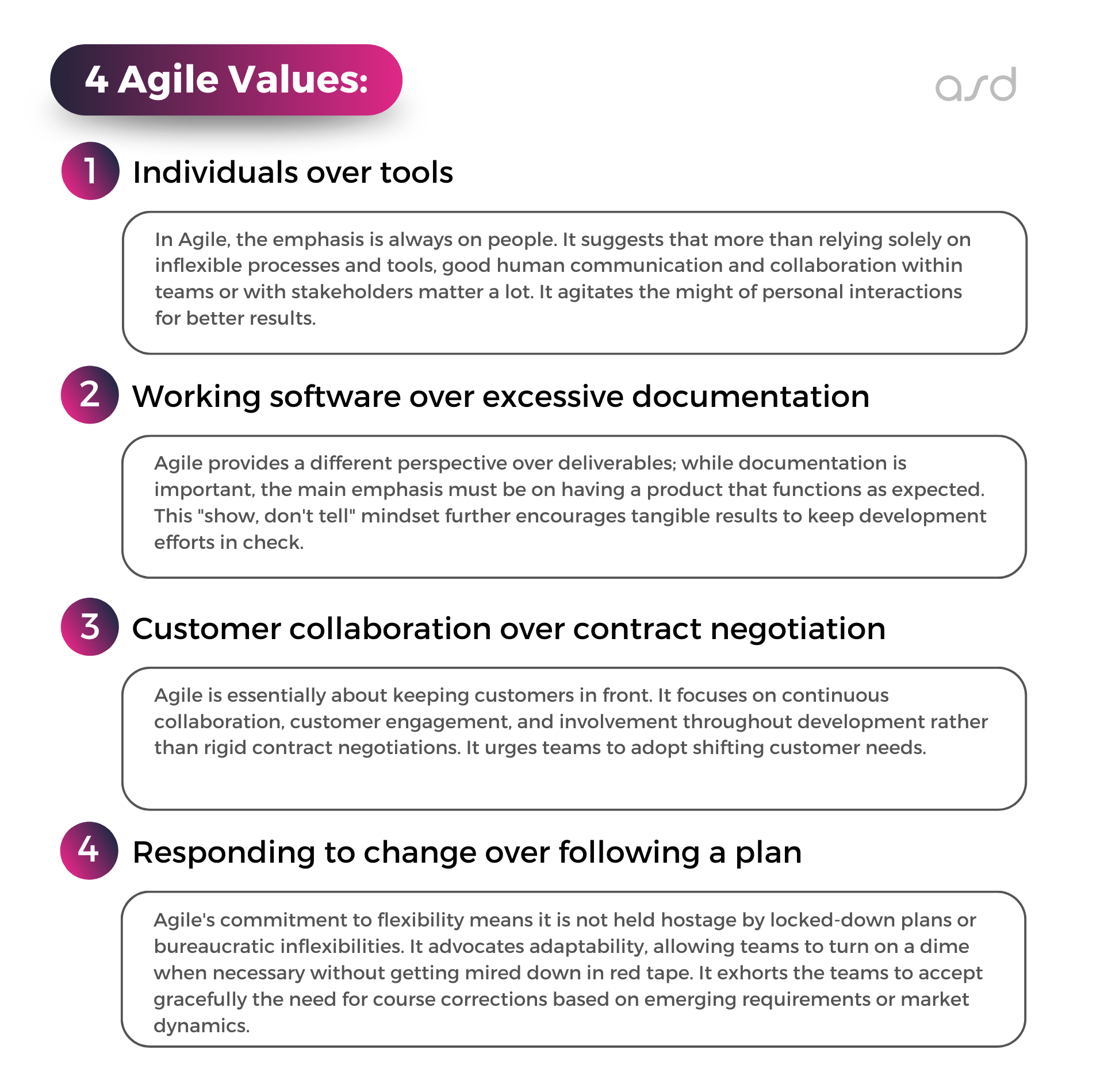
Why do companies choose the agile approach to software development?
The 4 decisive reasons to choose agile over anything else are:
- Flexibility. It gives the companies a chance to make a pivot in plans along with changing business demands and valuable client feedback. Thanks to such an approach, emerging client needs can be accommodated speedily while keeping agile in dynamic market situations.
- Testing. This is not just a phase in the project – it is done in every sprint. It means from day one of the product development lifecycle that it goes through several tests before store release happens. With continuous feedback, any problem or bug gets identified and resolved at an early stage. Continuous testing allows for prompt identification and resolution of issues throughout the development cycle.
- Proactive product ownership. Agile is biased towards the proactive participation of product owners. Collaboration amongst all stakeholders is encouraged for a better understanding of the client’s requirements. Involving the product owner more closely into the development process helps having clear communication and alignment of project goals.
- Better quality and faster results. Active participation of the product owners in the development enhances the quality of the product to a great extent. The constant availability of the product owner during the sprint period ensures that everything is kept on schedule all through. This alignment contributes to the delivery of high-quality results in a shorter time frame.
Traditional project management VS Agile?
Two distinct methodologies stand out: traditional and Agile project management. While both have their merits, it’s vital to understand the differences to choose the one that suits your company.
Traditional project management, like Waterfall, is based on systematic planning, detailed paperwork, and the implementation of preplanned methods. It works well in a linear manner where one stage has to be achieved for the other one to begin. While this methodology presents a clear roadmap, it may face challenges in responding adequately to changes especially where the conditions of the project shift abruptly.
The most popular approaches we know are Waterfall and Scrum. We will zoom in on the methods for you so you have a clear grasp of their differences. The Scrum framework, a specific approach within Agile methodologies, emphasizes structured roles and ceremonies that enable teams to adapt and evolve throughout the development process.
Compared to the traditional approach, Agile has proven resilient to unexpected change. The fact is reflected in numbers: The CHAOS Report states that only 14% of traditional projects are completed on time, within scope, and within budget. The same report highlights that 44% of traditional projects fail due to changing project requirements. Not compelling enough, right? Extreme Programming, another specific Agile framework, emphasizes coding best practices and engineering discipline, implementing methods like pair programming and test-driven development to enhance iterative development.
| Aspect | Waterfall | Agile |
| Approach | Linear and Sequential | Focused on flexibility, teamwork, and change |
| Phases | Each phase is completed before moving on to the next | A project divided into smaller, manageable units |
| Change
management |
Challenging to make changes once a phase is completed, often requiring going back to the beginning | Change is expected and embraced |
| Project
requirements |
Requires well-defined and stable project requirements up front | Adaptive to evolving requirements |
| Meetings | Not specific to Waterfall | Collaboration and cross-functional teams |
Agile Frameworks and Methodologies
Agile frameworks and methodologies provide a structured approach to agile development, enabling teams to deliver high-quality software quickly and efficiently. These frameworks offer a set of principles, practices, and tools that guide agile teams in their work.
How to assemble the right Agile team?
When we are talking about forming a team, it does not mean you have to hire the most expensive and expert team. The main point here is to correctly define what specialists you need to cover all the project development needs, so each team member has its mission and value. A cross-functional group is essential in Agile projects as it integrates various skills and roles within the team, enabling them to adapt flexibly and efficiently deliver project outcomes. For instance, when you decide not to hire business analysts, you risk getting the wrong product requirements in projects. For your information, a study by the Project Management Institute proves that inadequate requirements gathering is a primary cause of project failure in 37% of cases. This can lead to prolonged and challenging development, even with a team of exceptionally skilled developers. Moreover, such a choice not only impacts the pace of software delivery but also jeopardizes meeting user needs effectively. In essence, it becomes a total drain on both time and resources.
What are the types of agile teams?
Structures of the development team
It depends on the type of cooperation with the client. The development team can work:
-
Alongside the client’s team (if there is such)
In this case, the team is responsible for a certain amount of work, such as developing a specific functionality or feature. To achieve the best result we have a knowledge transfer to synchronize the work with the internal team.
-
Autonomously on the contractor’s side and report to the client
When working autonomously, here is more about the technical side of the development as all the organizational and other duties, such as sales and marketing, are on the client’s side. The development team gets clients’ demands, and Business Analysts transform them into detailed software development requirements for the team to develop them.
What specialists are there in the Agile team?

What are the roles and responsibilities of the Agile delivery team?
Each member has a specific role to do within the team and each is equally vital for a successful project delivery. Here we discuss the basic agile team structure and roles and, of course, what they do on their part.
- Project manager. You can’t go far without a professional Project Manager when developing software. The PM is responsible for meeting each product development milestone on time, solving all the issues throughout the development process, and connecting the Product Owner with the development team. The scrum master role is also crucial, focusing on facilitating collaboration, ensuring Agile principles are followed, and maintaining transparency within the team.
- Business Analyst. Business Analyst translates non-technical ideas into well-written and clear technical requirements, which are transformed into a product’s features by software engineers. A strong BA expert is a must in the team as product quality directly depends on the quality of requirements that they make.
- Tech lead. Tech lead is responsible for project tech realization and in their field of responsibility are frameworks, different tools, and programming languages
- Developers. Developers are the people who do the core job – developing the software. There are two main types of developers – front-end and back-end developers. The first one is responsible for developing the external side of the software, or in simpler words, the part users interact with directly while using the software. The second is responsible for writing code and developing the core of the software, its algorithms, and business logic.
- DevOps. DevOps are practical combinations and tools that are aimed to make traditional development processes faster and more efficient by removing barriers between development and operations. It fosters communication and collaboration which makes the DevOps model a great way for teams to work together.
- Quality Assurance Engineers. The QA team’s role is to guarantee the best final product quality through precise testing and revealing all the bugs and issues the product has. It is important to fix them as soon as possible to make them cheaper and easier.
- UI\UX designers. They develop the interface design of the product, defined by requirements. It can be a menu, buttons, pages, and others.
- Product owner. The product owner has to control and prioritize product requirements due to the need to reach the desired result and to take part in the development process to ensure the development of the product goes smoothly and in the right direction. Usually, the product owner is on the client’s side. Key roles like the product owner and scrum master are essential for guiding collaboration and enhancing team performance in a dynamic environment.
These agile team structure roles and responsibilities are fundamental. You can hire more narrow specialists – that’s up to you, but never compromise on a single link because it can affect the quality in a bad way.
What does the typical agile development team structure look like?

What are the must-have tools for agile teams?
You will find various management tools out there, but we recommend using these tried and tested ones that have established their reputation in the market for top-notch usability.
- Jira. The one-stop solution for all your management needs while working with Agile is Jira by Atlassian. It is loaded will all the required functionality to edit user stories, create sprints, and monitor development through Kanban boards as well as Scrum boards.
- Trello. In Trello, you can create step-to-step lists and cards with a visually oriented task organization feature that ought to resonate with many Agile teams.
- VersionOne. Supporting Scrum, Kanban, and SAFe methodologies, VersionOne has robust Agile flexibility with features like backlog management, sprint planning, and reporting.
- Asana. This is a tool popular for its ability to be applied in many Agile workflows including the creation of tasks and task prioritization, allowing team members to collaborate.
- Confluence. It’s a collaboration documentation tool, which works well with Jira. This one helps Agile teams create and share project documentation including requirements and meeting notes.
- GitHub/GitLab/Bitbucket. These are some of the code collaboration platforms that help a lot in Agile development, as these help manage code, track changes made to the code and even collaborate with other people while coding.
- Slack. Slack is a real-time messaging application that facilitates instant messaging, and sharing files and integrates perfectly with several other tools for better interconnectivity.
- Miro. It is the digital whiteboard and collaboration tool that agile teams use for visualizing workflows, user-story mapping as well as remote retrospectives and planning sessions.
What does the agile development process look like?
The agile software development life cycle consists of 6 phases. They cover the whole path from an idea to the closing phase when the project has to be closed.
-
Concept
The first step in development is where you define the whole further development process. In the list, we have to define the scope of work, develop the main requirements of the functions and features needed to develop the product in the first place, set deadlines, define possible risks and issues that can challenge the development, and estimate approximate costs.
-
Inception
The inception phase is the software development start, where all the requirements are accurately defined.
-
Development phase (iteration)
The main part of the process starts here when the development team has tasks and aims. It takes the most time among other steps. Here is the process that conveys previously made requirements for features and functions into fully working software
-
Testing and final product release
Before releasing the product, it is essential to conduct testing by the QA team, who will ensure that the product has no issues or bugs. In case there are bugs, the QA team will fix them. Be aware that you can not eliminate all the bugs during pre-release testing, as new bugs can emerge even after the release.
-
Maintaining
It is a crucial phase of the product. The maintenance phase takes care of supporting software on the market, fixing bugs that emerge, upgrading the product according to user feedback, and other processes that are necessary for support.
In the Agile software development life cycle, all these processes are utilized by the development team for each iteration, emphasizing the cyclical nature of Agile methodology compared to traditional linear approaches.
-
Ceasing support
It is the closing phase of software where the software can not perform its purpose and satisfy customer needs. There are two ways further: completely update the software according to the new market needs and trends, and closely support the product to create a new one.
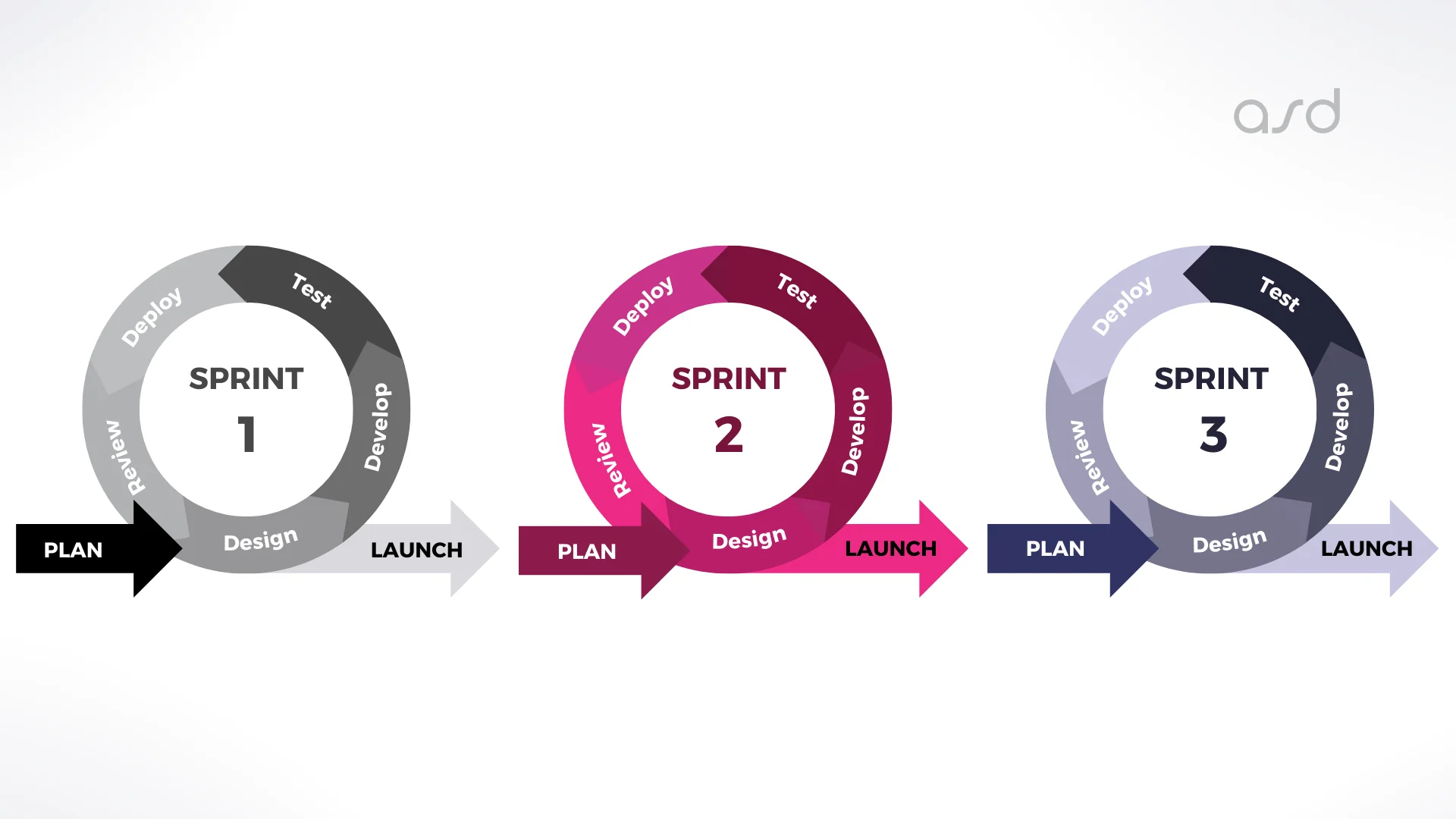
Stages of software development and what they have to do with the team structure
Typically, they are research, ideation, design, development, and iteration, but our company has a slightly different picture. There are three stages of software development at ASD Team which were designed based on our 15 years experience of working with different types of clients and project types to help both us and clients achieve more efficient results during and after the actual software development.
Initiate
At this early stage, it’s all about getting to know the project inside and out. Our team dives in, asking questions, analyzing, and brainstorming potential adjustments where needed.
Roles involved:
- Stakeholders
- Account Manager
The account Manager is responsible for constant communication with the client, which includes gathering information and feedback about the project and working process. It can be performed by the Project Manager as well, but it depends on who has tighter relationships with the client.
The Initiative stage includes the following activities:
- setting the development environment (accounts, credentials, repositories, CodeStyle, additional tools, DevOps consultation, QA team);
- backlog and board review;
- knowledge transfer and communication plan of transferring the information from the client’s team to ours.
Execute
This stage is an important one in terms of detailed planning and further development process. It includes the following:
- time required for the development testing and deployment; creating tickets and assigning them to the development team members who will be working on a certain task;
When we reach the development stage itself, here is where the coding process starts. Along with the coding, there are:
- regular requirements review in the roadmap;
- analysis of requirements and formalization if everything is clear for the PM, BA, and QA.
Pair programming is also utilized during this stage to enhance collaboration between programmers and ensure code quality. This technique involves one programmer writing the code while another reviews it in real time, fostering teamwork.
Our team presents all the developed features and functions to the client at the end of each sprint. That allows us to receive feedback from the client and to clear the further steps and actions regarding the development of the software itself
Roles involved:
- Project Manager
- Business Analyst
- Developers
- QA
- DevOps
Evaluate
The evaluation stage is not a single-time performance as we are constantly gathering feedback from our development team and the client to evaluate how the working process on the project is going.
After each sprint, commonly biweekly, there are retrospective meetings where the team discusses and shares feedback about the last sprint. It helps gather all the necessary information to improve some sprint drawbacks in the next one.
Moreover, each month there is a separate meeting conducted by an Account Manager or Project Manager aimed at gathering the overall feedback directly from the client to understand if the client is satisfied with our cooperation and how we can improve our software development outsourcing services and the whole development process.
Roles involved:
- Project Manager or Account Manager
- Business Analyst
- Developers
- Stakeholders
- QA
How to build a high-performing agile team: step-by-step guide
The flawless agile team structure is based on healthy team practices. Some of them are:
-
Conduct a deep analysis of the project needs
Start from the identification of the project’s requirements and goals, like whether you want a generative AI in travel, understand it, and keep an eye on the price in the designated goal. Get down to the client’s vision, user needs, and business objectives. This allows for a team structure fully attuned to the dynamics of the project through analysis.
-
Make sure there are no skill gaps
Evaluate the knowledge and skills of the development team members. Highlight any possible skill or expertise gap that might slow down project progress. Make sure that each member of the development team has such competencies to deliver their best for the project.
-
Adjust communication within the development team
Any Agile methodology points out the importance of communication. Encourage members to converse with each other to foster collaboration, information sharing, and fast decision-making. This will include daily stand-up meetings with every team member present, occasional retrospectives for analysis, and transparent documentation considering all parties involved.
A sense of ‘teamness’ enhances overall team performance and helps achieve set objectives through shared accountability for both successes and failures.
Let’s form your ideal agile team Feel free to ask any additional questions you might have. Our experts will be glad to assist you

Improving Team Collaboration
Improving team collaboration is critical to the success of agile teams, as it enables them to work together effectively to deliver high-quality software. Effective collaboration ensures that all team members are aligned with project goals and can contribute their expertise to achieve the best results.
Tools and Technologies for Agile Teams
Agile teams use a variety of tools and technologies to support their work, including project management software, version control systems, and collaboration tools. These tools help teams plan, track, and manage their work, and facilitate communication and collaboration.
Agile Development Best Practices
Agile development best practices provide a set of guidelines and principles for agile teams to follow, ensuring they deliver high-quality software quickly and efficiently. These practices help teams stay aligned with agile principles and continuously improve their processes.
Signs you have a productive Agile product development team:
- The team has perfect communicationGood communication is the key to success. Properly adjusted and aligned communication channels in an agile software development team are a must and a sign of a productive team.
- Properly divided responsibilitiesWell-defined responsibilities and roles make the software development process work as it has to work.
- The team is autonomousA team that understands the project doesn’t need constant supervision and motivation to perform the job. The autonomous teams do their job as they know what and why should be done.
Looking for a tech partner for your project?
Our team has talented experts who can help you develop your product
Looking for a tech partner for your startup?
In sum, we have an excellent methodology that makes the software development process flexible and adjustable to change what positively impacts the speed and quality of software development.
References:
statista.com
Questions? Answers!
Should I Transition to Agile?
If your project scope permits, that’s a smart move for your company. It provides flexibility, better client collaboration, faster results, and many other perks. Just make sure your team and clients are on board.
Which disadvantages (pitfalls) of agile methodology?
Despite all the pros, there are also some problems with agile software development. It needs experienced team members, can lead to scope changes, and may be tricky with remote teams. Among other disadvantages of agile methodology, it requires constant client input and communication. Be ready to handle these issues if you go Agile.
Does agile development work for every project?
Agile is flexible and works well for many projects, especially those with changing requirements. However, for projects with strict budgets or regulations, it may not be the best fit. It depends on your project’s needs.

